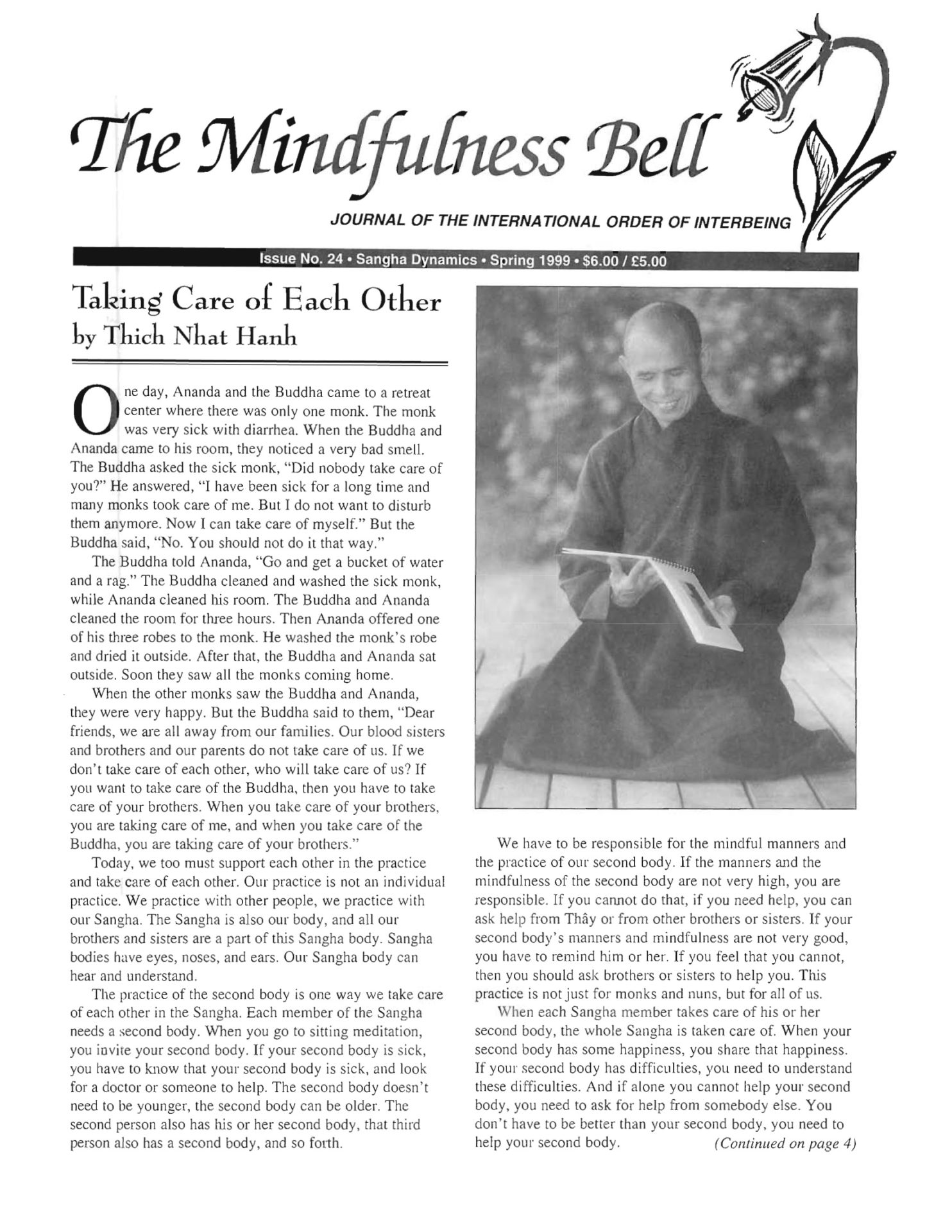By Mitchell Ratner in March 1999
Four years ago, a friend and I realized that the lift we received from Sunday night Washington Mindfulness Community gatherings didn’t quite get us through the week. I asked Crossings, a nearby holistic healing center where I teach mindfulness classes, if we could use their attic room on Wednesday mornings. “Yes,” they responded enthusiastically. So we announced the new sitting to the Sangha and other friends, and began. In the early days,
By Mitchell Ratner in March 1999
Four years ago, a friend and I realized that the lift we received from Sunday night Washington Mindfulness Community gatherings didn't quite get us through the week. I asked Crossings, a nearby holistic healing center where I teach mindfulness classes, if we could use their attic room on Wednesday mornings. "Yes," they responded enthusiastically. So we announced the new sitting to the Sangha and other friends, and began. In the early days, there were sometimes only one or two of us, but soon five to ten people showed up regularly.
Our routine is quite simple. We gather at 6:30 a.m., sit, walk, sit, and then do a short reading. In the beginning, we read from the Plum Village Chanting Book. More recently, we have read books such as Peace Is Every Step, section by section. By 7:30 we are putting on our shoes downstairs, and after a few minutes of optional conversation, people get on with their day. Occasionally, a group continues their discussion at the neighboring cafe.
The crispness of the mornings combined with the intimacy and stability of the group made the morning sittings unexpectedly powerful and addictive. About two years ago, several Wednesday morning regulars began asking about doing more: "Why not Friday morning?" Again, Crossings readily agreed. We had developed a comfortable symbiotic relationship with the Crossings staff. While using the same building, we hardly ever saw each other, though several of the acupuncturists mentioned that the building felt more alive on the days we sat. (We do give Crossings a small contribution for the use of the space.)
Recently, the desire for more mindfulness practice opportunities arose in conversations again-from morning regulars who wanted to add another morning, and from people in the community who had attended one of my Thursday night class series but couldn't attend in the morning. So we began 1999 with another expansion, adding sessions Monday mornings and Wednesday evenings. And realizing the mindfulness practice at Crossings had taken on an energy of its own, we gave that energy a name: Still Water Mindfulness Practice Center.
Just saying Still Water Mindfulness Practice Center seems to make people smile. The phrase "Still Water" evokes images of calmness and clarity. It is in the Psalms: "He leadeth me beside the still waters." It appears often in Plum Village gathas and guided meditations: "I see myself as still water, reflecting all that is." Still Water is also the name of the large meditation hall in the Plum Village Upper Hamlet. "Mindfulness Practice" connotes the open and energizing way of being in the world cultivated through attention to the present moment, as well as the specific meditative tradition taught by Thich Nhat Hanh.
The guiding vision for Still Water MPC is to provide opportunities for newcomers and experienced practitioners to deepen and share their mindfulness practices. The spiritual heart of the Still Water MPC seems to be the early morning sittings, because of their regularity, intimacy, and supportive energy. I often think of our mornings as a piece of Plum Village transported to Takoma Park: waking early, silently walking to the meditation hall in darkness, and then collectively creating a space of calmness, in and around us, while the sky lightens.
Wednesday evenings, we begin with a mindfulness practice, such as guided meditation, Touching the Earth, or total relaxation, followed by a 45 minute openhearted discussion on embodying mindfulness in our lives. In addition to some of the morning regulars, the evenings have drawn many new people from the community, who are looking for spiritual practice.
The Thursday night classes, which I have taught since 1994, are now considered part of Still Water MPC, though they have a separate history and have been a somewhat separate community. Currently, two twelve-week series are offered each year: an introduction to mindfulness practice class in the fall and a mindfulness at work class in the spring. Unlike the other sessions, the classes require advance registration, regular attendance is expected, and there is a fee. Because the format is unusual-systematic presentations within a supportive small group-the classes have attracted many participants willing to drive to Takoma Park for the twelve weeks, but who then find more local opportunities to continue their practice.
For me and many of the Still Water regulars, the expansion of group practice opportunities and coming together as a center has changed our lives. Four years ago, we were testing an implicit hypothesis that if weekly group practice helped nourish our mindfulness amid the stress and distraction of urban life for a day or two, more frequent sessions might nourish it longer. We are now finding that when we practice together several times a week, the nourishment of group practice is not confined to specific parts of the week, but pervades the week as a whole.


